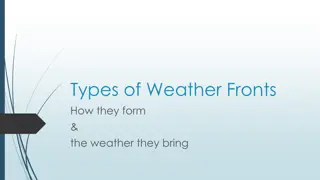Understanding Weather Fronts and Associated Forces
Learn about typical cold fronts, warm fronts, and occluded fronts, along with the key forces at play such as Pressure Gradient Force (PGF) and Coriolis Force (COR). Discover how these forces influence the movement of air parcels in different weather systems.
Download Presentation

Please find below an Image/Link to download the presentation.
The content on the website is provided AS IS for your information and personal use only. It may not be sold, licensed, or shared on other websites without obtaining consent from the author. Download presentation by click this link. If you encounter any issues during the download, it is possible that the publisher has removed the file from their server.
E N D
Presentation Transcript
Typical Cold Front Convective precipitation 50 100 mile wide band along front
Typical Warm Front Clouds and precipitation precede surface front Stratiform clouds starting about 750 miles from front Stratiform precipitation starting about 350 miles from front Overrunning
OCCLUDED FRONTS Heavy precipitation along front Convective or stratiform Short duration
REVIEW OF KEY FORCES Pressure gradient force (PGF) High to Low Perpendicular to the isobars Proportional to isobar spacing Coriolis force (COR) Acts to right of parcel direction in N. Hemisphere (and to left in S. Hemisphere) Maximum at poles, zero at equator Proportional to wind speed (Chap. 8, pp. 210 214)
On the next slide, identify the forces associated with the geostrophic wind acting on the air parcel (box) over Arkansas. This is a 500 mb map.
PGF is from higher to lower pressure (or, in this case, heights). For geostrophic flow, COR is equal (in magnitude) and opposite (in direction) PGF COR
COR acts to the right of the geostrophic wind in the Northern Hemisphere, so the wind is WNW, parallel to the height contours. PGF Vgs COR
Now identify the forces associated with the gradient wind acting on the air parcel (box) over Kentucky.
For flow around a curved path, the inward force (in this case PGF) is stronger than the outward (COR). The resulting gradient wind flows parallel to curved isobars (the wind goes around a curved path without crossing the contours). PGF Vgr COR
Finally, identify the forces associated with the surface wind acting on the air parcel (box) over Lake Huron.
PGF Friction Vsfc COR This looks more complicated than it is. Friction slows the wind, thereby reducing the magnitude of COR. PGF is unaffected. The resulting balance is cross-isobaric flow TOWARD LOW PRESSURE. COR is always to the right of the resulting wind (in the N. Hemisphere) and friction is always opposite the wind direction. So more friction gives you more cross-isobaric flow and a weaker wind.























